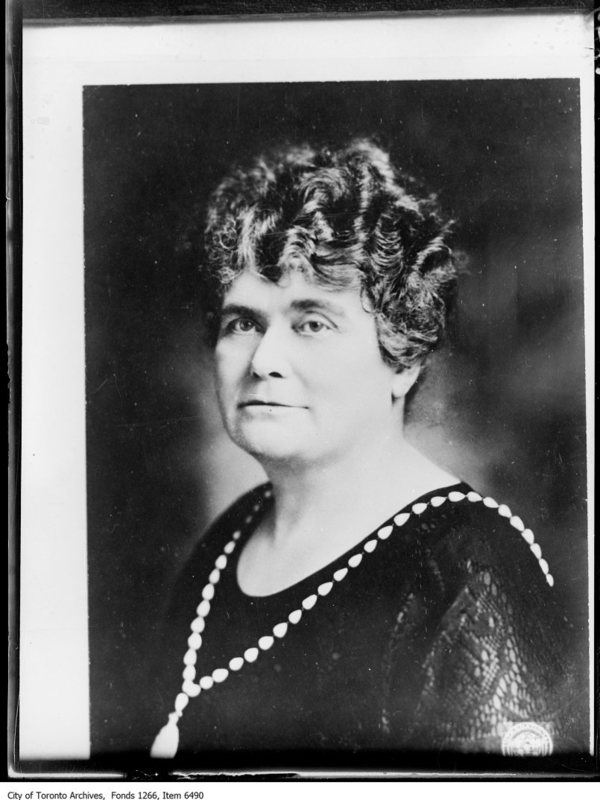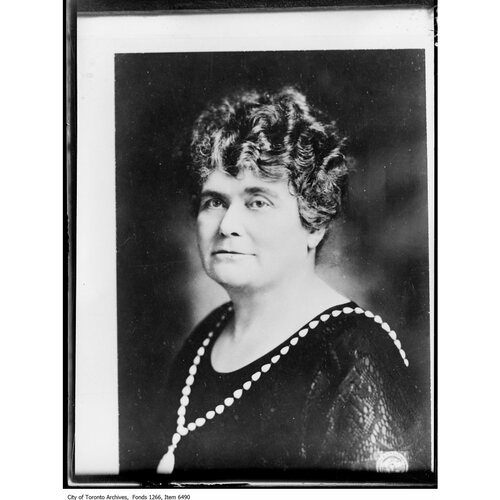
Source: Link
BROWN, CAROLINE SOPHIA, teacher, physician, and school-board trustee; b. 30 Jan. 1862 in Derry West (Mississauga), Upper Canada, daughter of David Brown and Margaret Armstrong; d. unmarried 11 Jan. 1936 in Whitby, Ont.
Caroline Sophia Brown’s parents, who were farmers and stock-raisers in Peel County, had nine children, of whom she was the fourth. Her father was a leader in the Presbyterian Church and a prominent Orangeman. Caroline grew up working on her grandfather’s 300-acre farm. As a young girl, she learned to drive a team of horses and was put on the harrow. By age 10 she was milking cows. According to an article in the National encyclopedia of Canadian biography, written shortly before her death, her strong physique had allowed her to work for many years “like a steam engine.”
Brown was inspired by her sisters to become a teacher. After completing public school at Derry West, she attended Jarvis Street Collegiate Institute in Toronto and Brampton Collegiate Institute. She then taught in Halton County and in the village of Palestine (Mississauga), as well as at four schools in Toronto (Dovercourt, Gladstone Avenue, Queen Victoria Public, and Ogden Public).
While working as a teacher, Brown enrolled in the Woman’s Medical College, which had been founded by Michael Barrett* and others with the backing of Dr Emily Howard Stowe [Jennings*] in 1883. (It would become the Ontario Medical College for Women in 1894.) Brown attended lectures after her school day was over and stayed into the evening to do dissections. She graduated from the Ontario Medical College for Women and from Trinity Medical College, with which it was affiliated, on 22 May 1900. After she wrote her licensing examination in 1900, she was told that she had failed to pass in all but two subjects. Undaunted, she continued her studies while teaching school for another nine years. In 1909, as she prepared to retake the examination, the officials reviewed her records and discovered that she had actually passed in all subjects during her first attempt. She received her licence to practise on 22 Oct. 1909.
Brown interned for eight months at the City Hospital in Watertown, N.Y., where she focused on surgical work. She then pursued postgraduate studies in obstetrics and gynaecology at the Rotunda hospital in Dublin. In England she studied at the Great Ormond Street Hospital in London and at hospitals in Birmingham. She completed her postgraduate work in France and Germany, concentrating on general surgery. After her return to Toronto, she served for several months with the medical-inspection staff responsible for the health of schoolchildren. She went on to practise medicine in Toronto for over 25 years, including at Women’s College Hospital [see Minerva Margaret Greenaway*].
Active in community service, Brown took a leading role in many important women’s organizations, including the Local Council of Women. She was especially vigorous in the movement for women’s enfranchisement. A keen public speaker, she was often called upon to give lectures to women’s organizations. During the First World War, she was energetic in recruiting and in soldier welfare. She applied to go overseas herself but was not accepted, so instead she taught first aid and home nursing to a number of young people who were among the first to go abroad. She was a founder and regent of the Sir William Osler chapter of the Imperial Order Daughters of the Empire [see Margaret Smith Polson*], which sent an ambulance to France for the war effort. In recognition of her work in first aid and home nursing during the war, she was made an honorary life member of the St John Ambulance Association [see George Ansel Sterling Ryerson*] in 1916.
Brown’s interest in education had led her to run for the local school board. In 1915 she was elected as a Conservative candidate for the Toronto Board of Education, the only woman trustee at that time. In 1917 she was joined on the board by Ada Mary Courtice [Brown*] (no relation), who, the previous year, had founded the Toronto Home and School Council, a middle-class school-reform organization that sought to assist women in running for public office and to promote their involvement in local educational politics. In 1919 Mrs Edith Sarah Groves [Lelean] also became a member. Brown was re-elected in 1917, 1918, 1919, 1923, and 1925 (by acclamation in 1918 and 1923). In 1918 she was chosen to chair the property committee and was the first woman to serve in that role. During the war, when prices were rising, she had advocated higher salaries for teachers. (She also promoted the installation of sinks in schools so that students could wash their hands.) In 1924 she represented the board at the League of the Empire’s Imperial Education Conference in London, England. While in London, she was invited to be the Canadian delegate to the meeting of the Medical Women’s International Association, also being held there.
In federal politics Brown chaired the Ward Five Women’s Liberal-Conservative Association from 1920 to 1923 and was nominated as its candidate for the federal riding of Toronto Northwest. She ran as an independent Conservative in the election of 29 Oct. 1925 but lost to the official Conservative candidate, the former mayor of Toronto, Thomas Langton Church*.
Brown was known for her keen intellect and seemingly inexhaustible physical vigour. She was a member of the Ladies’ Orange Benevolent Association and was drawn to British Israelism, a movement whose members believed that the British were descended from one of the ten lost tribes of Israel [see Joseph Wild*]. In her later years her activities were greatly curtailed by illness; she fractured her foot in 1926 and subsequently developed osteomyelitis, from which she did not recover. The cause of her sudden death in hospital was recorded as myocardial failure, complicated by exhaustion from cerebral arteriosclerosis.
Caroline Sophia Brown’s advocacy of women’s rights and her concern for the welfare of children are evident in her many achievements in education, medicine, and public service. She regarded children as the citizens of tomorrow and believed the care of their physical fitness and spiritual well-being to be the highest calling.
AO, RG 80-8-0-1680, no.026516. LAC, R233-34-0, Ont., dist. Peel (39), subdist. Toronto (A), div. 4: 15; R233-35-2, Ont., dist. Peel (140), subdist. Toronto (A), div. 4: 13; R233-37-6, Ont., dist. York West (131), subdist. Toronto, Ward 6 (G), div. 4: 12. “Conservatives capture every seat in Toronto and York,” Globe, 30 Oct. 1925: 13. Globe, 13 Jan. 1936. Kari Dehli, “For intelligent motherhood and national efficiency: the Toronto Home and School Council, 1916–1930,” in Gender and education in Ontario: an historical reader, ed. Ruby Heap and Alison Prentice (Toronto, 1991), 147–63. “Dr. Caroline Sophia Brown,” Canadian Medical Assoc., Journal (Toronto), 34 (January–June 1936): 356. National encyclopedia of Canadian biography, ed. J. E. Middleton and W. S. Downs (2v., Toronto, 1935–37), 1.
Cite This Article
Alison Li, “BROWN, CAROLINE SOPHIA,” in Dictionary of Canadian Biography, vol. 16, University of Toronto/Université Laval, 2003–, accessed December 31, 2025, https://www.biographi.ca/en/bio/brown_caroline_sophia_16E.html.
The citation above shows the format for footnotes and endnotes according to the Chicago manual of style (16th edition). Information to be used in other citation formats:
| Permalink: | https://www.biographi.ca/en/bio/brown_caroline_sophia_16E.html |
| Author of Article: | Alison Li |
| Title of Article: | BROWN, CAROLINE SOPHIA |
| Publication Name: | Dictionary of Canadian Biography, vol. 16 |
| Publisher: | University of Toronto/Université Laval |
| Year of publication: | 2023 |
| Year of revision: | 2023 |
| Access Date: | December 31, 2025 |



